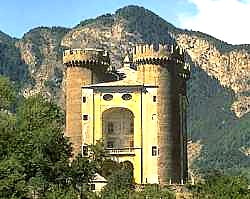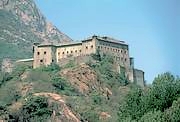Eine vertikale Region könnte man sagen. Nicht nur physisch gesehen, denn
das Aostatal wird durch viele Gipfel abgegrenzt (vor allem Montblanc, 4807 Meter,
höchster Gipfel Europas), sondern auch für die in einer relativ kleinen
Region so zahlreich vorhandenen Naturschönheiten, Denkmäler und kunsthistorischen
Werke von großem Wert.
 A
vertical region, you might say. And not just in the
physical sense, for the many high peaks that surround
it (including Mont Blanc, the highest mountain in Europe
at 4,807 metres), Valle d'Aostabut also for the surprising
concentration, in a region of such reduced dimensions,
of so many natural splendours, so many monuments, so
much precious historic and artistic heritage. A density
which evokes, in its vertical aspect, the crowding of
skyscrapers in a metropolis where horizontal urban space
is scarce and precious. Aosta, the regional capital
and the only province of the Valley, is a city rich
in history. Traces of the ancient Augusta Pretoria (the
Latin name of Aosta) can easily be seen, such as the
great Arch of Augustus (25 B.C.) and the remains of
the Roman Theatre. For Aosta the Middle Ages were anything
but dark: as an important centre of commercial traffic
with France and Switzerland, the city enjoyed a long
period of prosperity.
A
vertical region, you might say. And not just in the
physical sense, for the many high peaks that surround
it (including Mont Blanc, the highest mountain in Europe
at 4,807 metres), Valle d'Aostabut also for the surprising
concentration, in a region of such reduced dimensions,
of so many natural splendours, so many monuments, so
much precious historic and artistic heritage. A density
which evokes, in its vertical aspect, the crowding of
skyscrapers in a metropolis where horizontal urban space
is scarce and precious. Aosta, the regional capital
and the only province of the Valley, is a city rich
in history. Traces of the ancient Augusta Pretoria (the
Latin name of Aosta) can easily be seen, such as the
great Arch of Augustus (25 B.C.) and the remains of
the Roman Theatre. For Aosta the Middle Ages were anything
but dark: as an important centre of commercial traffic
with France and Switzerland, the city enjoyed a long
period of prosperity.
 It
is no coincidence that the Cathedral and Cathedral Church
of S. Orso, two churches of great beauty, date back
to the Middle Ages. Other medieval monuments lie at
the feet of the city: the castle of Fénis and,
in the vicinity of Saint-Vincent (the location of a
famous casino), the castle of Issogne, whose unusually
rich frescoes and architecture confirm the prosperity
of that time. The natural landscapes of the Valley are
fabulous: from the imposing peaks of Mont Blanc to the
fascinating harshness of Cervino (4,478 metres), from
the spectacular Monte Rosa (so called due to colour
assumed by its great glaciers at certain times) to the
Gran Paradiso, the high mountain at the centre of the
huge Natural Park of the same name (over 200,000 hectares).The
holiday towns and ski resorts of the Valley are long-established
and well-known: Courmayer and Breuil-Cervinia are the
most famous
It
is no coincidence that the Cathedral and Cathedral Church
of S. Orso, two churches of great beauty, date back
to the Middle Ages. Other medieval monuments lie at
the feet of the city: the castle of Fénis and,
in the vicinity of Saint-Vincent (the location of a
famous casino), the castle of Issogne, whose unusually
rich frescoes and architecture confirm the prosperity
of that time. The natural landscapes of the Valley are
fabulous: from the imposing peaks of Mont Blanc to the
fascinating harshness of Cervino (4,478 metres), from
the spectacular Monte Rosa (so called due to colour
assumed by its great glaciers at certain times) to the
Gran Paradiso, the high mountain at the centre of the
huge Natural Park of the same name (over 200,000 hectares).The
holiday towns and ski resorts of the Valley are long-established
and well-known: Courmayer and Breuil-Cervinia are the
most famous

